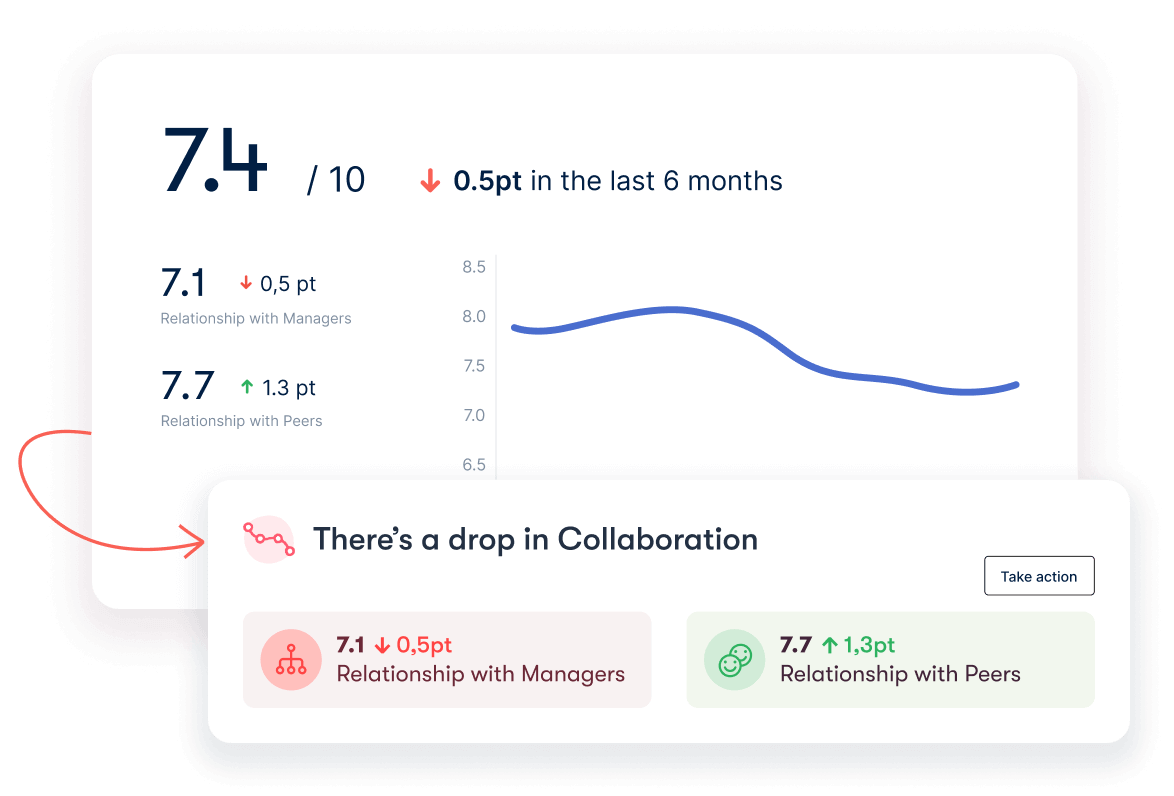Continuous feedback is one strategy savvy businesses are using to achieve productivity improvements. They recognize this technique helps them make ongoing improvements in engagement.
Peter Drucker, the management theorist, said, “what gets measured gets improved.” So if you want to enhance team morale, it makes sense to measure how your employees feel about their jobs. Once you have this data, you are primed to make mission-critical improvements.
Implementing a continuous feedback model in your team is a great way to start making changes. Instead of guessing and hoping, you gain the data you need to enhance employee performance.
Assess your organization’s employee experience in minutes

The DL on continuous employee feedback
What is continuous employee feedback?
Continuous team feedback is all about creating an ongoing communications loop.
Ongoing feedback allows employees to regularly share their feelings and concerns with managers while also allowing managers to share their concerns.
Traditionally, managers only gained visibility into employees’ feelings during their annual performance review. This meant that problems could simmer for up to 12 months before being addressed. Managers were always behind the curve and out of touch with current team sentiment.
Inevitably, this would lead to declining productivity, employee dissatisfaction, and perhaps high employee turnover— significant issues for any organization.
While annual reviews still hold value, they are not enough on their own: there’s a real need to monitor employee sentiment throughout the year.
Continuous feedback is a great way to gauge whether or not you're on the same page as your employees. A constructive feedback loop gives you ongoing insights into what’s working well and what needs to be improved.
What are the employee performance benefits of continuous team feedback?
When you keep making small improvements, the changes soon add up to momentous progress. Creating a continuous feedback cycle is a fantastic way to better your organization.
There are many reasons why ongoing feedback wins out as the best performance management system for monitoring and assessing employee morale:
Faster problem resolution
When receiving performance feedback, you will be alerted to problems as they arise. This means you can take action to nip issues in the bud, reassuring your team that you will respond rapidly to address their concerns.
Problems that are allowed to bubble can quickly tank team spirit and often go unnoticed by management. Fixing these issues as they arise improves performance management and keeps your people motivated.
Improved employee engagement
Employee engagement is a crucial indicator of success in the workplace. Team members who interact regularly show that they feel involved and valued.
When team members have an outlet to express their concerns or put forward new ideas, they are more likely to contribute. Gathering informal feedback regularly encourages greater engagement, with all the positive associations that manifest as a result, such as:
- Improved productivity
- Better team spirit
- A happier working environment

A model for better performance management
While any improvement is good, a pattern of ongoing improvement is exponentially better.
Minor enhancements quickly add up to big changes. Like a snowball that gets ever larger as it rolls, continuous feedback arms you with more and more data to fuel your progress.
Businesses often collect customer feedback regularly as it is critical to their success. But employees are equally important stakeholders in your company, so you need to ensure they are happy, too.
How to collect continuous feedback from your team
Gathering regular feedback is a valuable exercise that can impact your organization’s success. But how do you implement a system that collects the data you need?
Collecting feedback is easier than you might expect: all you need is a simple plan to follow. To get you started, these are the critical actions to consider:
Request employee feedback
The consistent feedback model begins with gathering your team’s ideas and opinions. In the past, managers would collect feedback by sending emails to employees, then wait for replies, and collate results in spreadsheets.
Many organizations still use a good old-fashioned suggestions box, which is often the only way employees get a voice in the business. As a business grows and scales, this type of continuous feedback process becomes increasingly inefficient.
It’s easy to see the flaws in these more traditional processes. Emails can get lost in crowded inboxes and questions are left unanswered. Building out spreadsheets with all the responses is a slow, painstaking process, and after all that, it’s hard to extract any real meaning from the data.
The result? Employee feedback gets pushed down the list of priorities, and the potential benefits are lost. A lot of hard work goes to waste, and employees may become more frustrated than ever.
Why put yourself through all that when you can get better results more easily, simply by using software like Officevibe’s Employee Feedback tool.
Measure employee satisfaction
Of course, there’s no point in gathering data unless you put it to good use in performance management. Fortunately, that’s where today’s employee feedback software shines.
You can use management tools to analyze the information and weed out areas of concern. Find out which issues stand out as urgent problems or sift through data to identify significant patterns.
Measuring employee satisfaction is key, and using the data effectively is even more important.
Managers are often surprised at what the survey data reveals. In what seemed to be a happy team, there may be many pressing issues lurking below the surface. Just because people aren’t complaining, it doesn’t mean they are satisfied.
Take a page out of Eisenhower’s book and identify which issues are both urgent and important. Issues that fall under these categories demand your immediate attention but don’t neglect other matters; everything needs to be attended to in due course.
Translate feedback into action
Once you're clear on what changes are needed—and which are the most critical—you need to take action.
If a concern relates to a single individual, it’s probably time for a one-on-one meeting with a manager. Often, seemingly intractable issues can be resolved simply by talking things through. Even if a topic is difficult to broach, it’s important to start the process.
💡To help you, here are some proven examples of employee feedback, plus tips on how to give constructive feedback.
On the other hand, if the problem is a more general one, you need to figure out why it has arisen. Are there problems in your systems that need to be addressed? Have your workplace methods fallen out of step with modern practices?
Resolving professional issues can be challenging, but it’s always better than burying your head in the sand.
Once you’ve drawn up your action plans, remember to share them with your employees. Employee feedback that is translated into meaningful action will encourage your team to participate in the future, leading to better overall employee engagement.
Commit to continuous improvement
Your investment in a feedback tool will pay dividends when you make employee surveys a regular part of the workflow. Employees at every organizational level should consider survey participation to be as natural as completing timesheets or expense forms.
You can achieve high engagement by organizing surveys on a predetermined schedule, such as monthly or quarterly. Then everyone knows what to expect and can look forward to the opportunity to contribute. Used in conjunction with performance reviews, periodic surveys are highly effective.
Officevibe: the preferred continuous feedback tool
There are many reasons why businesses choose Officevibe as their preferred engagement survey software. But improving employee performance is undoubtedly a major contributing factor.
Our employee feedback tool helps you automate and organize how you collect anonymous employee feedback. Team members get to share anonymous continuous feedback with their managers, reducing the time between problems and their resolutions.

Ongoing Improvement
Managers get simple, clear reports that instantly help them understand the employee experience. Results can be shared easily with your team so that everyone’s on board with the cycle of improvement.
A massive return on investment
The hidden costs of damaged team morale are staggering. Not only will employees be less productive, but they may also spread dissent throughout your organization. They may quit their jobs, leaving you with the unexpected expense of hiring replacements.
Research by Gallup shows that 85% of employees are not engaged at work, or are actively disengaged. This costs the global $7 trillion a year and severely impacts profitability.
All of these issues can be resolved by adopting the principle of continuous feedback. You can turn your teams into engaged productivity powerhouses, staffed by people who love their jobs and their career prospects.
The conclusion is simple: it’s time to implement continuous feedback in your organization and take your team morale to the next level. With a happier and more productive workforce, there’s no limit to what you can achieve.
Equip HR and managers with tools to engage, recognize, and drive performance.




